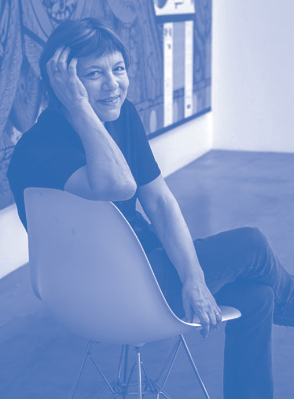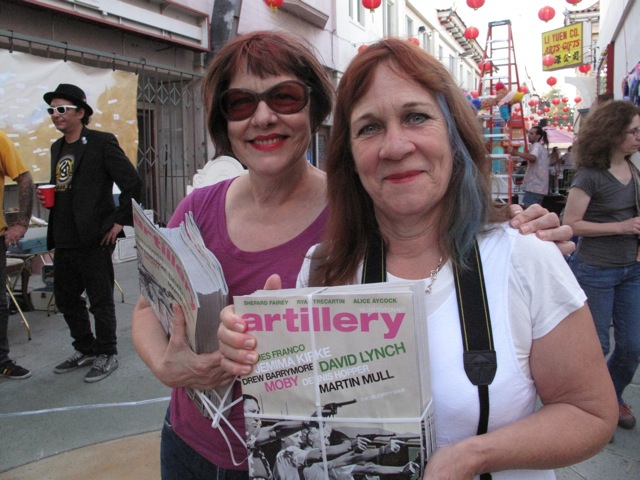 Dear Reader,
Dear Reader,
I have good news and bad news. Let’s start with the bad news: This, after 18 years, is my last editor’s letter. What an incredible journey it has been. Here’s the good news: Artillery will still carry on! More on that later.
I started this magazine with my late husband, Charlie Rappleye, in the summer of 2006. This career-turn was a surprise to me, as being an editor of a magazine was never on my list of what I wanted to be when I grew up. I’ve been an artist all my life. Whether I want to reenter that world after this, is another question. After being the editor of a contemporary art magazine in Los Angeles for nearly two decades—I now feel that I know too much. I’ve seen the machinations of the art world, and it’s not the prettiest picture, certainly not one I want to jump right back into as an artist.
But for now, I’d like to reflect on that incredible journey with the art world. Back in 2006, there was a severe dearth of readable LA art publications. A few quarterly nonprofit academic art journals were in circulation, but I found them to be deadly, and most people would silently agree. I had edited the local naughty art zine, Coagula, for a year, and enjoyed that immensely: I loved publisher Mat Gleason’s unfiltered take on the art world, but I wanted something in between—something that reflected the real world of an artist, something more daring and iconoclastic. Some humor, even?
By Artillery’s third year, a new tag line was added to our logo: The Only Art Magazine that’s Fun to Read! At that point we had comics, poetry, opening-party photo spreads, reports from Gotham City. There were fleeting columns with names like Throttle, The Poseur, Outer Space, Retrospect (by THE Mary Woronov), Under the Radar, AmmuNation, Private Eye, Off the Wall—and my fave, On the Wag with Mitchell Mulholland, our gossip column that was so snarky and sardonic that I was forced to kill it in the interest of survival.
We were off to a good start: The LA art world embraced us, and we hired Paige Wery at the end of our first year. Paige had never been a publisher, but none of us had experience in running an art publication either, so we took a chance. Turns out, she was a natural and boosted the magazine to another level. We went to art fairs, book fairs, threw parties, poetry readings and art debates. We traveled to New York, San Francisco and Miami. We were a great team—certainly a highlight for me in the magazine’s early years.
Getting to know the art world through a different lens sometimes soured me. Often, it just wasn’t my scene; I felt like an interloper. Then I’d run into artists like Mike Kelley, and all the sourness would disappear. He was so real and unpretentious. At art openings he was a delight, and we would crack wise. I would routinely pester him to let me interview him and eventually he agreed. I told him I’d contact him soon.
That’s when Kelley preempted me and sent a “letter to the editor” that bitch-slapped me about being maligned in our gossip column, and he demanded we cancel his subscription immediately. He added that he was looking forward to wiping his ass with the magazine, especially the Mitchell Mulholland page.

I think we all know how this story ends. Yes, I did get an interview with Kelley, but tragically it was his last interview. He was on the cover of our January 2012 issue when he took his own life. The interview was extraordinarily profound and eerily prescient. What happened was beyond heartbreaking.
Of course, I will never be able to blot that out of the magazine’s trajectory. The irreplaceable loss of Mike Kelley seemed to take the life out of the art world for a while. Why did he do it? He was right on the edge of grand success, the kind artists strive for, having just signed on with Gagosian. But he didn’t seem to be relishing it. In our interview he kept mentioning to me how his father referred to him as a Martian.
Being an artist or even proclaiming you were an artist used to feel like being an outsider or someone on the fringe. It wasn’t as acceptable or widely embraced as it is today; it certainly wasn’t thought of as a prudent career choice. With the plethora of art schools in Southern California churning out artists who have chosen to stay in LA, Artillery found no shortage of content to cover. A few times I invited our contributors to edit a theme they wanted to delve into, and many ended up as our most provocative issues. Contributor Tucker Neel pitched a “Queered” issue back in 2011. He gleefully pointed out that our cover of New York artist Kalup Linzy was the complete opposite of LA’s other art magazine, which at the time featured Ed Ruscha on its cover. I probably don’t have to spell it out, but, uh … straight old white male vs. queer young Black artist? In many ways, I felt Artillery was ahead of its time, certainly a unique publication. We had a 2008 issue on race long before the BLM movement, and a sex issue that had clients vow that they would never advertise with us again. One coverline, Contemporary Art Hates You (my John Waters interview) had my publisher screaming, “It looks like it says, ‘Artillery Hates You’”—I secretly loved that. Our Celebrity issue with Martin Mull on the cover was sort of genius, I must admit. I truly felt our magazine was the only art magazine that was fun!


And I did have fun with the magazine, but now, I’m not having as much fun, and for me, that means it’s time to move on. I believe what I created was and is something important to Los Angeles, being a significant art center. I hope you do too. That’s why it’s time for me to go and let someone else come in with fresh ideas and shake things up a bit. My successor is Daniela Soberman, whose first issue will be November. She believes in Artillery and knows its value in a big city like LA, as I did, and knows it can grow and maintain its integrity and devotion to quality art journalism.
With that, I bid my adieu. It’s been a great ride. I cannot thank my loyal freelancers and staff enough for all their dedication, hard work and enthusiasm. Many of you will be lifelong friends—such a treasure to me. And our advertisers, you literally kept us alive with your support and belief in Artillery. I know some of you had to rob your piggy bank to pay for that ad, but you knew the importance of having an excellent art magazine. Journalism is a dying art, and I have such respect for our advertisers that wanted to reward and keep that alive. And I didn’t forget about you, Dear Reader, for we simply would not exist without you.
Lastly, Artillery carried me through good and bad times in my own personal life. I never missed an issue, even when my husband died, going on six years now. I knew it would be the only thing that could get me out of bed during that deeply dark time in my life. Charlie believed in Artillery and wanted it to succeed in every way. I want that too, and now I get to sit back and watch its legacy live on.


